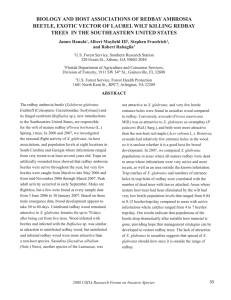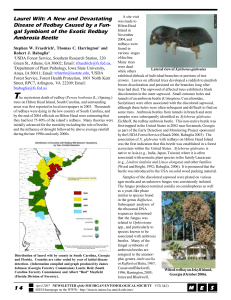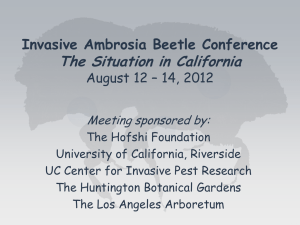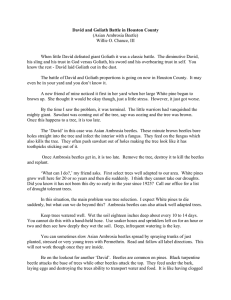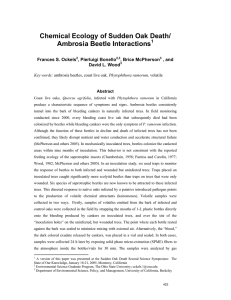What Happened with Ambrosia Beetles in 2014?
advertisement
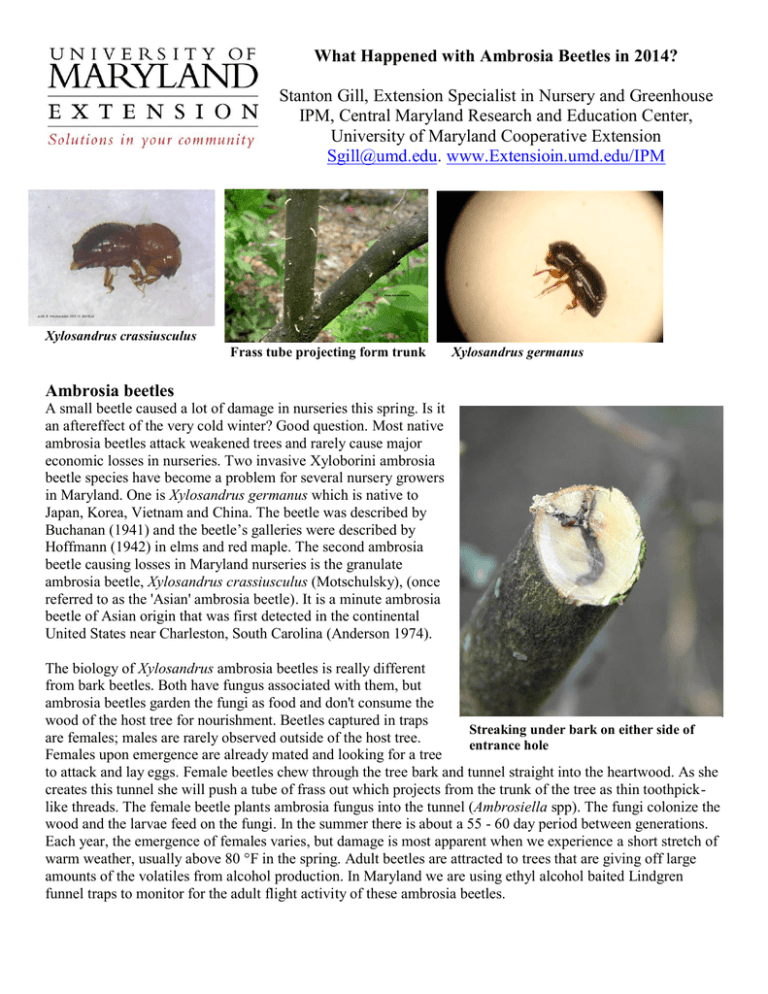
What Happened with Ambrosia Beetles in 2014? Stanton Gill, Extension Specialist in Nursery and Greenhouse IPM, Central Maryland Research and Education Center, University of Maryland Cooperative Extension Sgill@umd.edu. www.Extensioin.umd.edu/IPM Xylosandrus crassiusculus Frass tube projecting form trunk Xylosandrus germanus Ambrosia beetles A small beetle caused a lot of damage in nurseries this spring. Is it an aftereffect of the very cold winter? Good question. Most native ambrosia beetles attack weakened trees and rarely cause major economic losses in nurseries. Two invasive Xyloborini ambrosia beetle species have become a problem for several nursery growers in Maryland. One is Xylosandrus germanus which is native to Japan, Korea, Vietnam and China. The beetle was described by Buchanan (1941) and the beetle’s galleries were described by Hoffmann (1942) in elms and red maple. The second ambrosia beetle causing losses in Maryland nurseries is the granulate ambrosia beetle, Xylosandrus crassiusculus (Motschulsky), (once referred to as the 'Asian' ambrosia beetle). It is a minute ambrosia beetle of Asian origin that was first detected in the continental United States near Charleston, South Carolina (Anderson 1974). The biology of Xylosandrus ambrosia beetles is really different from bark beetles. Both have fungus associated with them, but ambrosia beetles garden the fungi as food and don't consume the wood of the host tree for nourishment. Beetles captured in traps Streaking under bark on either side of are females; males are rarely observed outside of the host tree. entrance hole Females upon emergence are already mated and looking for a tree to attack and lay eggs. Female beetles chew through the tree bark and tunnel straight into the heartwood. As she creates this tunnel she will push a tube of frass out which projects from the trunk of the tree as thin toothpicklike threads. The female beetle plants ambrosia fungus into the tunnel (Ambrosiella spp). The fungi colonize the wood and the larvae feed on the fungi. In the summer there is about a 55 - 60 day period between generations. Each year, the emergence of females varies, but damage is most apparent when we experience a short stretch of warm weather, usually above 80 °F in the spring. Adult beetles are attracted to trees that are giving off large amounts of the volatiles from alcohol production. In Maryland we are using ethyl alcohol baited Lindgren funnel traps to monitor for the adult flight activity of these ambrosia beetles. In most years we do not see damage from the second generation. In 2007 we received samples of fresh ambrosia beetle damage, wood frass tubes projecting from plants, in styrax, yellowwood and crape myrtle in July and August which indicates there was damage in 2007 from the second generation. In 2009 we received a sample of an active infestation in August in red maple. The red maple was growing in a wetland planting site. Two major flight activity times in 2013 – 4/10 to 4/17 for X. germanus May 22 – 26 for X. crassiusculus 2014- Xylosandrus germanus peaked 4/13/2014. Xylosandrus crassiusculus. (Peaked 5/21/2014) These invasive Xylosandrus species are attacking what appear to be healthy trees. For example in 2008 one nursery had major damage in 50 London Plane trees, 30 river birch, 30 Zelkova, all of which had been in the ground for 2 years and appeared to be growing vigorously and to be healthy the season before. In another nursery we examined heavy damage in sweet bay magnolia, sugar maple, styrax, and Chinese dogwood. Again, all of the trees had healthy amounts of growth the season before the infestation. Each of these nurseries were supplying plants with supplemental watering through a trickle irrigation system. In another case, a 2 acre private arboretum with an extensive planting of azaleas sent in samples of azaleas that were being damaged by a Xylosandrus crassiusculus. The manager reported extensive loss of azalea plants in 2008 and each subsequent year through 2014. In 2014 in April, nurseries reported heavy damage on yellowwood trees, hybrid dogwood ‘Venus’, styrax, and redbud. In another nursery, they lost over 60 trees in 2014 including zelkova and redbud. In May of 2014 we had reports of X. crassiusculus damaging European beech, Carpinus, paperbark maple, Cornus kousa hybrids, Rose of Sharon and Japanese maple. We also had an IPM Scout reporting ambrosia beetle attacks on mature Stayman apples grafted on M-7 understocks in Maryland in 2014. In June of 2014, we received a call from a Pennsylvania grower in Bucks County. This grower is growing in a fairly fertile clay loam soil in the ground. They had a problem with ambrosia beetles 12 years ago and have not seen any problems until this year. He basically had the same tree species we saw attacked by ambrosia beetles in Maryland this year including yellowwood, Chinese redbud, Stellar series dogwoods, Japanese maple, paperbark maples, zelkova, crape myrtle, and Halesia. The tree ages varied from 2 year old to 4 year old plants that were well established in the nursery field. He had root pruned the yellowwoods in October. The interesting one is that he had native dogwoods being attacked by ambrosia beetles. I have observed Cornus kousa and the hybrid Stellar series damaged in the past but not native dogwood, Cornus florida. He noted that with the native dogwoods that were attacked by ambrosia beetles within a month after the attack the wood was very brittle and snapped easily. He did not observe this brittleness in the other tree species. It is possible the winter desiccated the branches on the native dogwood. We have not observed any winter damage to Cornus florida in our Maryland nurseries. The European beech started to leaf out this spring, and then the leaves collapsed after the ambrosia beetle damage occurred. Some of the branches failed to leaf out, but others expanded their leaves then collapsed. The interesting thing is that 3 weeks ago when I observed the trees they still had 20 -30 % of the foliage expanded and looking fairly good. I just spoke with this nursery manager and he said 9 trees had totally collapsed. These trees were 8 -10” caliber. One tree I looked at with him 3 weeks earlier (this tree was much larger than the rest) that had been root pruned in October actually looked pretty good. Foliage was out on over 90% of the tree. Three weeks after the first observation we found two lower limbs that had collapsed leaves and ambrosia beetle damage on these branches. The rest of the tree looked good (3 weeks ago) but he said since this time over 50 % of the foliage collapsed and they found ambrosia beetles holes throughout the branches. The owner was thoroughly disgusted and had the European beech, paperbark maples and sytrax all cut down and removed. They estimate they suffered a little over $320,000 of tree loss this year. It would be interesting to find out if nursery owners are finding in other states such as the New England states. In Ohio, Chris Ranger was finding Xylosandrus attacking sugar maples and redbuds. Each tree that was being attacked had frost cracking on the trunk form the cold 2014 winter. We suspect that the cold injury on trees made them much more attractive to ambrosia beetle attack. In the case of the large European beech that collapsed in Maryland the severe dieback could be the result of winter damage and made the trees more susceptible to attack by ambrosia beetles. Work at North Carolina State University by Steven Frank has found that trees that are held waterlogged produce large amounts of alcohol and are highly attractive to ambrosia beetle attack. If trees are held very wet before foliage has emerged and the plant can’t transpire excess water through foliage, then the likelihood of attack is highest. It is suspected that waterlogged plant material under these anaerobic root conditions produce large amounts of alcohol. Some growers in Maryland have noted increased ambrosia beetle activity in plants growing in fields that retain moisture for great lengths of time. In other cases, nurseries growing in sandy loam and clay loam with good drainage still report heavy losses in spring, usually the first generation. In one case in Maryland in 2014 hybrid dogwoods, Cornus kousa hybrid ‘Venus’ suffered severe damage from Xylosandrus in April. Several hundred plants were killed. The nursery owner noted that 24 trees survived the attack. Each of the 24 trees had not been pruned in the winter of 2014. All of the trees that were attacked had been pruned in January and February of 2014. The trees were 1 ¾” to 2” caliber trees. The ambrosia beetle has caused extensive damage to a wide range of plants from 2002 to 2014, a time period in which we have been monitoring their activity in Maryland. Xylosandrus germanus and X. crassiusculus have been recorded feeding on over a 140 different species of plants. Some tree species that are commonly submitted to our lab have been damaged or killed by Xylosandrus germanus and Xylosandrus crassiusculus include yellowwood, birch, styrax, redbud, hybrid dogwoods, oriental persimmon, pawpaw, hybrid chestnuts, and crape myrtle Management Pyrethroids have been found to provide control of attacking adults if applied prior to the closing of the galleries with frass. In the nursery, either permethrin or bifenthrin applied to the main trunk and major branches has been used to control ambrosia beetles. Once the beetles are in the tree and have frass packed in the entry holes they are isolated from the outside. If infestations occur, affected plants should be removed and burned or chipped and composted, and trunks of remaining plants should be treated with an insecticide labeled for this pest. Once an infestation started, some nursery managers left the trees to serve as trap trees. The growers destroyed these trap trees before the end of the 55-day life cycle of the first generation of ambrosia beetles. Please Let Us Know what you are seeing We would like to know if other nursery owners saw similar damage in the different states. Please contact me at 410-868-9400 or sgill@umd.edu
